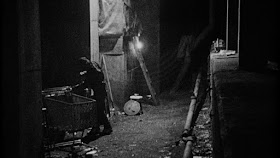Marc Singer’s documentary Dark Days (2000) reveals much about homeless living in Amtrak tunnels beneath New York City. To construct its narrative, Singer and his subjects create a world where the city is a dangerous place, a wilderness, and the homeless seek shelter where no one else will go. Singer and his subjects also work together to alter the underground landscape to accommodate filmmaking and follow a three act structure: 1. Going underground (with introductions to each character), 2. living like a family in the relative domestic bliss below, and, 3. after a forced removal by Amtrak officials overseeing the tunnels near Penn Station, climbing back up above ground to begin living isolated lives in single-person apartments.
Act one begins with a representative of the homeless, Greg, descending out of a dark urban landscape into the relative domestic comfort below. The normalcy of living in shanties built in subway tunnels is emphasized by portrayals of each of the “main characters” waking up in their shanties and getting ready to go to work, providing a glimpse of the ordinary lives Greg, Ralph and Tito lead. The focus of this first act seems to instead be on the individual tales the homeless tell that explain not only how they ended up homeless and why they moved under ground, but also on the hell above they escaped by entering this underground world. The introductions to the characters also highlight their immersion in the middle class values exemplified by focus on work and, especially, on workin’ on the house—civilizing the underground.
Singer shows us what these homeless do to survive in the second phase of his documentary, which climaxes with a view of how they cope with a transition from their underground community to a life above ground. Here we see each subject leaving home and reentering the city streets to earn a living. Tommy collects plastic, proud that he collects enough from selling bottles to take the weekend off. And Greg sells anything he doesn’t keep himself. But they all return to their self-built homes for comfort. The world these subjects have created has become so civilized that they can own and nurture others, including pets. Yet subjects must also contend with rats and must fight to maintain a civilized life in the underground where the city hides not only the source of its progress, but also the real consumer products—human and animal waste. Hygiene and waste center this final scene before the film’s climax.
The climax of this narrative occurs when an Amtrak order to leave within thirty days breaks up the family and domestic world subjects have built for themselves below ground. A homeless advocate, Mike Harris, however, provides the story’s resolution. He works with Amtrak officials and promises that no one will be left in the tunnel if all the homeless get housing above ground. Amtrak agrees, and the underground pioneers are elated. Dee, Tommy, Brian, Ralph and Greg all jubilantly destroy their underground homes. But Dark Days does not suggest that the only solutions to such urban problems are institutional—gained through public organizations’ interventions. Instead, the film (and Singer, its creator) foregrounds how well the homeless subjects adapt their environment and themselves to not only survive but prosper in their, perhaps, savage underground world. Individuated through their stories and their uniquely furnished homes, especially Ralph (with friends Tito and Dee) and Tommy (with friend Brian) prove the resilience of humankind and suggest that the best way to solve environmental problems, both rural and urban, is to construct narratives that intertwine humans with each other and with their environments. And the best ethnographic films seem to be those constructed by both the filmmakers and their subjects.







No comments:
Post a Comment